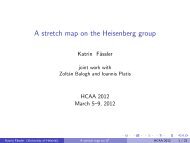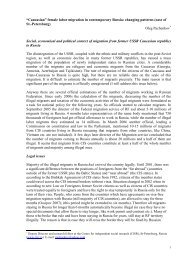Experiential metaphors in Latin - Wiley Online Library
Experiential metaphors in Latin - Wiley Online Library
Experiential metaphors in Latin - Wiley Online Library
You also want an ePaper? Increase the reach of your titles
YUMPU automatically turns print PDFs into web optimized ePapers that Google loves.
322<br />
TRANSACTIONS OF THE PHILOLOGICAL SOCIETY 109, 2011<br />
This is the case with the above-mentioned examples: both share the semantics of an <strong>in</strong>com<strong>in</strong>g<br />
psychological state. Structural variation is highly important <strong>in</strong> verify<strong>in</strong>g a metaphorical<br />
schema’s productivity because it constitutes further evidence for the functional and formal<br />
openness of a given pattern.<br />
To sum up, the schema has shown itself to be flexible and open enough to be subsequently<br />
exploited and semantically ref<strong>in</strong>ed <strong>in</strong> different ways. Hence, it came to express quite diverse<br />
mean<strong>in</strong>gs perta<strong>in</strong><strong>in</strong>g to different experiential subfields, as Fig. 3 shows.<br />
Figure 3. The EVENTS ARE MOVEMENTS metaphor <strong>in</strong> Lat<strong>in</strong><br />
At the highest level of schematicity we f<strong>in</strong>d the ‘Basic Event Type Metaphor’, i.e. EVENTS<br />
ARE MOVEMENTS. At a lower level we have the two schema-specific <strong>metaphors</strong> CONTRACTING A<br />
DISEASE IS A FALLING and INCEPTIONS OF PSYCHOLOGICAL STATES ARE ENDPOINTS OF TELIC<br />
MOVEMENTS, which are <strong>in</strong> bold boxes as they are more frequent, and were probably entrenched<br />
<strong>in</strong> the m<strong>in</strong>ds of speakers (token frequency determ<strong>in</strong>es the degree of entrenchment of a s<strong>in</strong>gle<br />
word or construction: Croft & Cruse 2004: 308; see §11.3.1 for a detailed overview).<br />
Compell<strong>in</strong>g evidence for this comes from the fact that they may give rise to novel,<br />
semantically related low-level metaphor <strong>in</strong>stantiations and they partially admit formal<br />
variation. Bold l<strong>in</strong>es <strong>in</strong>dicate that these superord<strong>in</strong>ate and more schematic constructions<br />
entail a productive relation with regard to less frequent and less entrenched schemas.<br />
The data presented <strong>in</strong> this section po<strong>in</strong>t towards some generalizations. First, high token<br />
frequency of a metaphorical schema may promote a higher level of entrenchment. Second,<br />
high token frequency facilitates analogy (Barðdal 2008: 89ff.), here understood as the ability<br />
of a metaphorical schema compatible with very few verbs to extend its syntactic pattern to<br />
other <strong>metaphors</strong>, <strong>in</strong> view of the lexical similarity shared by the fillers of the model and<br />
the target constructions, respectively (e.g. they both trigger emotional states). Third, <strong>in</strong><br />
order to be productive, a metaphorical schema needs to be cast at its proper degree of<br />
schematicity. In this case, the relation hold<strong>in</strong>g between the constructions <strong>in</strong> the bold boxes<br />
and the general metaphorical schema EVENTS ARE MOVEMENTS is one of different levels of<br />
schematicity: the specific experiential subord<strong>in</strong>ate schemas are relatively less schematic than<br />
the generic metaphor because they apply to a relatively narrow range of lexical<br />
constructions, all restricted to the doma<strong>in</strong> of experience. Therefore, this schema seems to<br />
be semi-productive with regard to Lat<strong>in</strong> experiential <strong>metaphors</strong>, as it <strong>in</strong>stantiates only two<br />
productive patterns and does not fully exploit the potential range of forms <strong>in</strong> relation to the<br />
wide semantic doma<strong>in</strong> that it actually covers, i.e. movements. Insofar as ‘productivity is the<br />
degree to which a schema is more entrenched than its <strong>in</strong>stantiations’ (Clausner and Croft<br />
1997: 255), I suggest that this is not the case as the <strong>in</strong>termediate <strong>in</strong>stantiations of the general

















